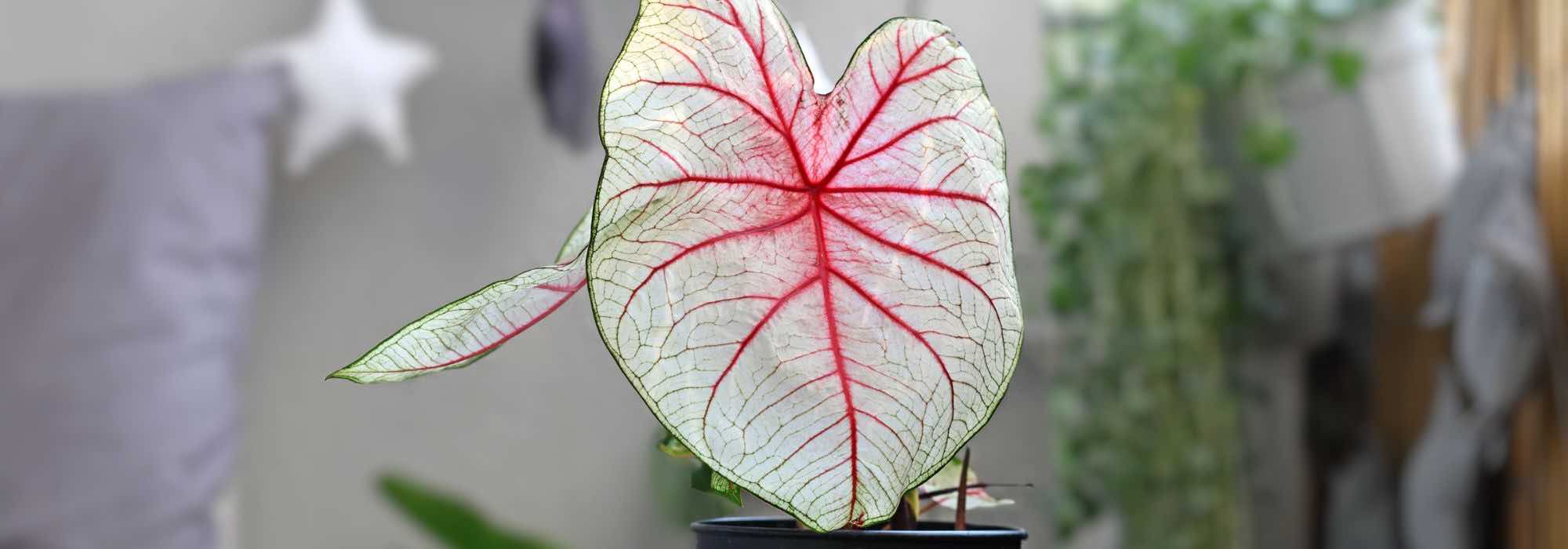
Caladium Indoors: Care Throughout the Seasons
Our best tips
Contents
Caladium is a tropical bulbous plant prized for its spectacular foliage in shades of pink, red, white and green, sometimes called “Angel Wings”. Native to the forests of South and Central America, it stands out for its large heart-shaped leaves, which add a touch of colour and exoticism to any interior.
Like all bulbous plants, Caladium follows a precise rhythm: it begins growth in spring, fully develops in summer, then enters dormancy in autumn before resting in winter. Its care therefore varies according to the seasons. In this guide, discover when and how to plant a Caladium bulb, how to care for it indoors, and how to store it properly in winter.
Spring: Resumption of Caladium Growth
When to Plant Caladium Bulbs?
If you’ve stored the tubercles over winter, it’s time to replant them, and the same applies if you’ve just purchased them. Planting the bulbs is ideally done from March-April, at a minimum indoor temperature of 20°C.
How to Plant a Bulb or How to Revive a Caladium?
- Choose a good substrate: a light, well-draining mix is ideal. A universal or indoor plant potting compost, light and high-quality, enriched with perlite, helps prevent excess moisture around the bulb.
- Position the tubercle correctly: plant it about 5 cm deep, with the rounded side facing upwards.
- Water moderately: a light watering right after planting is sufficient. Excess water could cause the bulb to rot before germination.
- Maintain a stable temperature: the bulb needs warmth to start. Place the pot in a room where the temperature is around 20-25°C to encourage germination. Ideally, place your Caladium pots in a mini greenhouse to increase warmth and humidity until the leaves develop properly.
With these precautions, the first shoots should appear after 3 to 6 weeks. Patience is key.
Once the first leaves emerge, it’s time to adopt a suitable care routine. Indoors, this plant needs specific conditions to thrive.
Where to Place Your Caladium?
The Caladium prefers bright light without direct sunlight. Place it near an east or bright north-facing window (avoid overly cold exposure), or south or west-facing with a sheer curtain to filter the sun’s rays, where it will enjoy good light without the risk of scorching.
→ Avoid: Full sun exposure, which could dry out its delicate leaves and cause brown spots.
Watering and Humidity: Finding the Right Balance
The Caladium likes moist substrate and ambient humidity but dislikes stagnant water.
- Water regularly: the substrate should stay slightly moist but never waterlogged. On average, watering every 3 to 4 days is sufficient in spring, but always check the substrate’s condition. Ensure the bottom of the pot isn’t waterlogged.
- Ideally use non-calcareous water: hard tap water can leave white marks on the foliage and cause mineral buildup in the substrate. Rainwater or filtered water is preferable.
- Increase ambient humidity: indoors, the air is often dry, especially with heating or air conditioning. To prevent leaves from drying out, use a spray bottle to mist the leaves (without overdoing it) or a humidifier. Keep your Caladium at 50-70% humidity.
→ Note: Lack of humidity can cause leaf curling or dry edges.
Fertiliser: Feeding Your Caladium for Healthy Growth
Once the first leaves appear, it’s time to feed your plant.
Apply a balanced liquid fertiliser for green plants (NPK 10-10-10 or 20-20-20) every 4 to 6 weeks. Always dilute the fertiliser in the watering water.
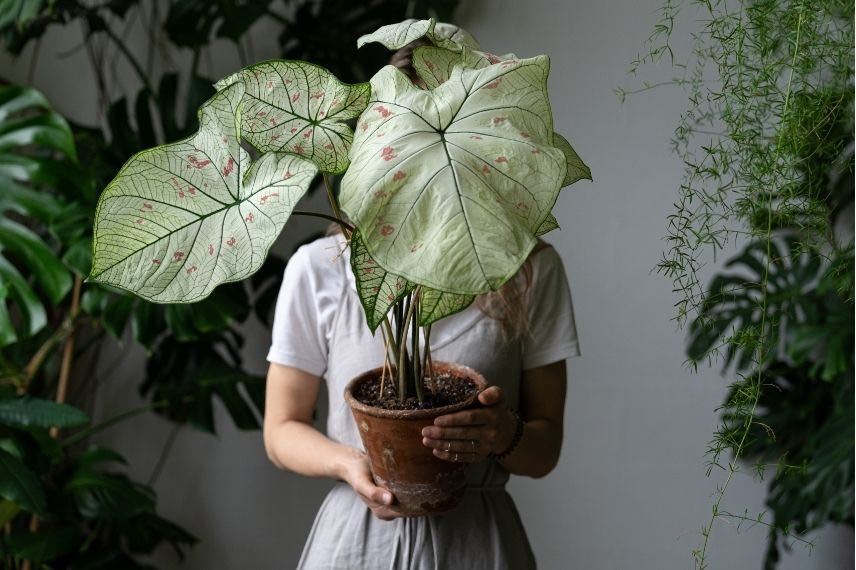
Caladium leaves can be truly impressive under good growing conditions
Summer: Full Growth of the Caladium
How to care for a Caladium indoors during summer?
- Watering: in summer, evaporation is faster and the soil dries out more quickly. Water as soon as the surface of the soil begins to dry, approximately every two to three days, depending on the ambient temperature. Ensure water does not stagnate in the saucer to prevent root rot.
- Humidity: Caladiums thrive in high humidity. Your indoor environment may be drier, so pay attention to maintaining good ambient humidity.
- Fertiliser: as summer is its peak growth period, the Caladium needs nutrient support for foliage development. Maintain the dosage indicated in spring but stop applications during periods of intense heat.
What problems may arise in summer?
- Yellowing leaves: a sign of overwatering or overly compacted soil preventing drainage.
- Presence of parasites: spider mites and aphids may appear, especially in dry air. See our article on Caladium diseases and parasites.
Can Caladiums be grown outdoors?
Yes, absolutely! If you have outdoor space, you can move your Caladium outside during the warmer season, provided temperatures remain above 15°C.
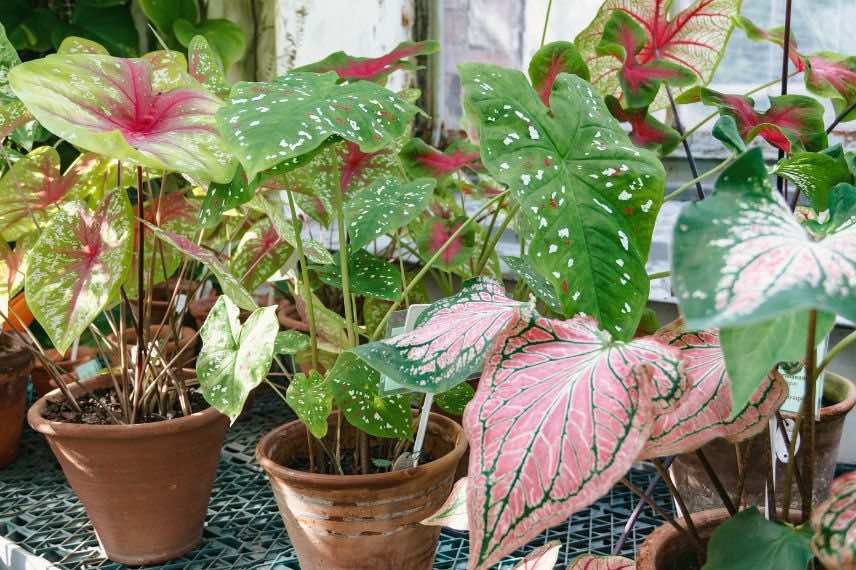
You can certainly move your caladiums outdoors during the warmer season
Autumn: Preparing for Dormancy
Why do Caladium leaves fall?
In autumn, the Caladium slows its growth and gradually enters dormancy. Its foliage begins to yellow, then wilts entirely. This is a natural process: the bulb goes dormant to replenish its reserves before the next growth season.
As days shorten and temperatures drop, the Caladium responds by reducing its activity. It’s therefore essential to adjust care to help it transition smoothly.
- Reduced watering: Once you notice yellowing leaves, gradually space out watering. Shift from frequent summer watering to moderate water once a week, then every fortnight, until stopping completely. Excess moisture during this period could rot the bulb.
- Stop fertilising: Fertiliser should be discontinued as soon as the foliage starts yellowing. The goal is to let the plant enter dormancy naturally without forcing growth that will no longer occur.
- Light management: At this stage, light exposure becomes secondary. If the plant still has some leaves, leave it in place, but once they’ve fully wilted, you can move the pot to a shadier, cooler spot.
Should you cut yellowed leaves?
Yes, but not immediately. Let the leaves dry completely before cutting them at the base. As long as they’re still slightly green, they continue to provide nutrients to the bulb. Once fully wilted and brittle, remove them carefully without damaging the bulb.
How to store Caladium bulbs in winter?
You have two options depending on your preferences and climate:
- Leave the tubers in the soil: If you grow your Caladium in a pot and the room temperature stays above 15 °C, simply stop watering and let the bulb remain dormant in its pot until spring. When warmer weather returns, resume watering gradually.
- Dig up the bulbs for storage: If you want to optimise their preservation or if your indoor temperature is too cool, you can remove the bulbs from the substrate once the foliage has completely dried.
- Dig them up carefully to avoid damage.
- Clean them by removing excess soil, but don’t wash them with water.
- Let them air-dry for a few days in a dry, well-ventilated spot.
- Store them in a paper bag, cardboard box, or container with turf or dry sand, at 15–18 °C.
Winter: period of dormancy
In winter, the Caladium is in complete rest. Its foliage has disappeared and its bulb remains in dormancy until milder temperatures return.
Should you water a Caladium in winter?
No. Once the bulb has entered dormancy, watering should be stopped entirely.
At what temperature should Caladium bulbs be stored?
The bulb should be kept between 15 and 18 °C. Below this temperature, it risks being damaged and may struggle to regrow in spring. If the bulb has remained in its pot, ensure it is placed in a temperate room, protected from the cold. An unheated conservatory or a damp cellar are not suitable.
A quick check from time to time is recommended. If you notice signs of mould or rot, remove the affected bulb immediately to prevent it from contaminating the others. If the bulb appears too dry or shrivelled, it can be lightly moistened by briefly wrapping it in a damp cloth before returning it to storage.
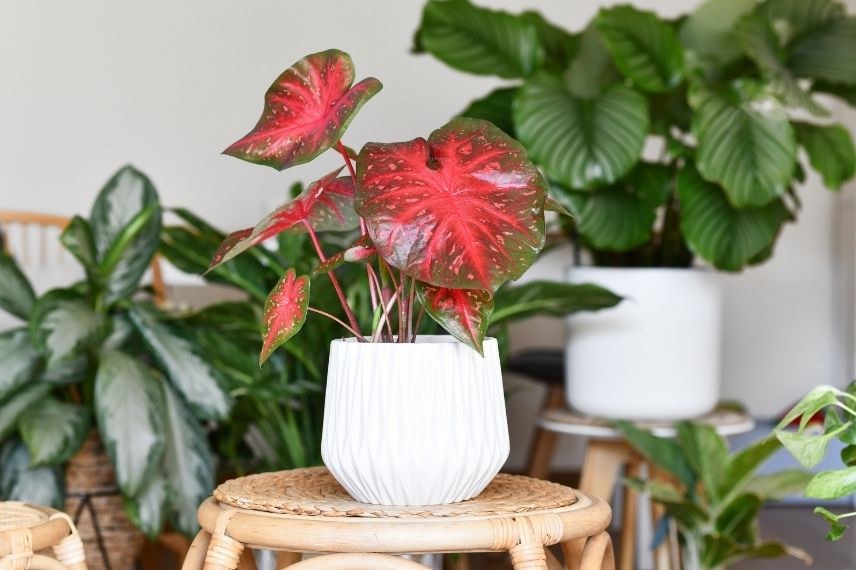
- Subscribe!
- Contents
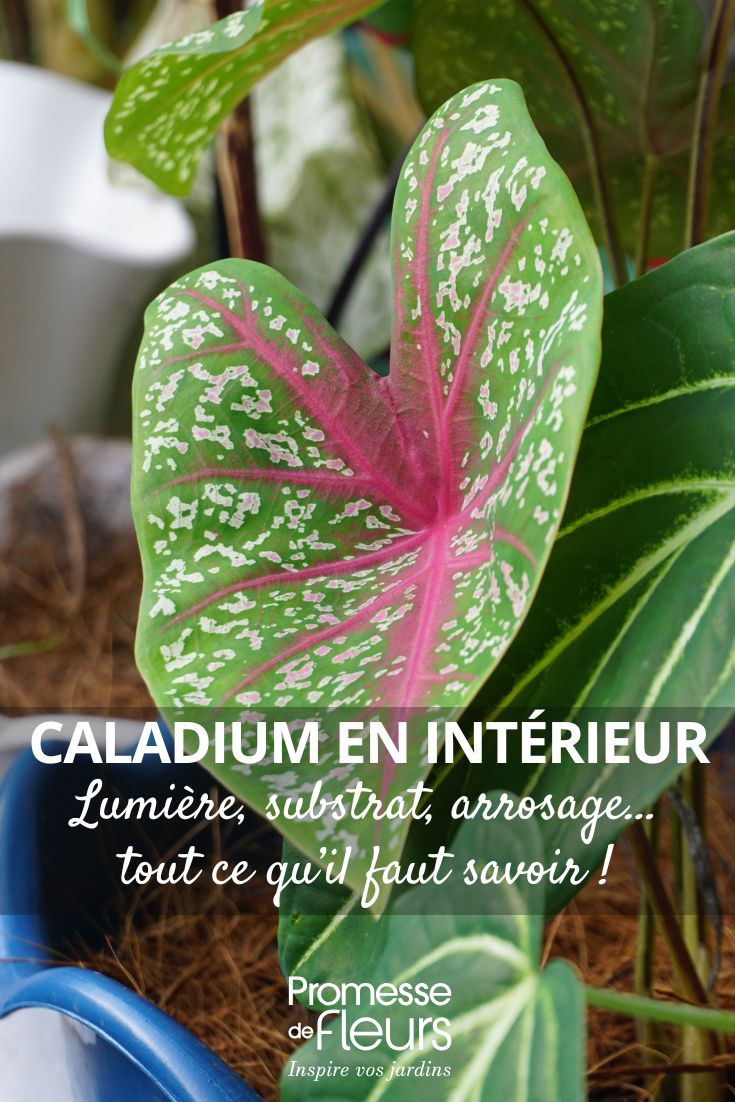































Comments